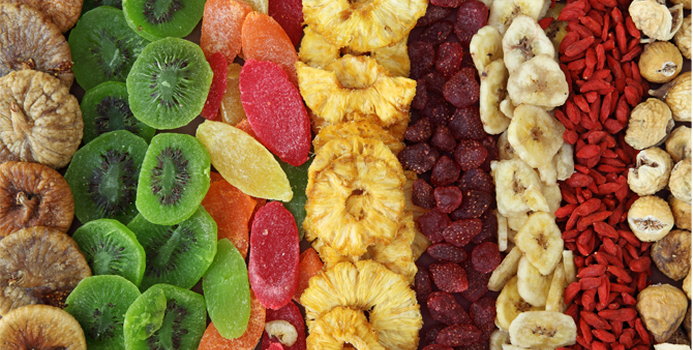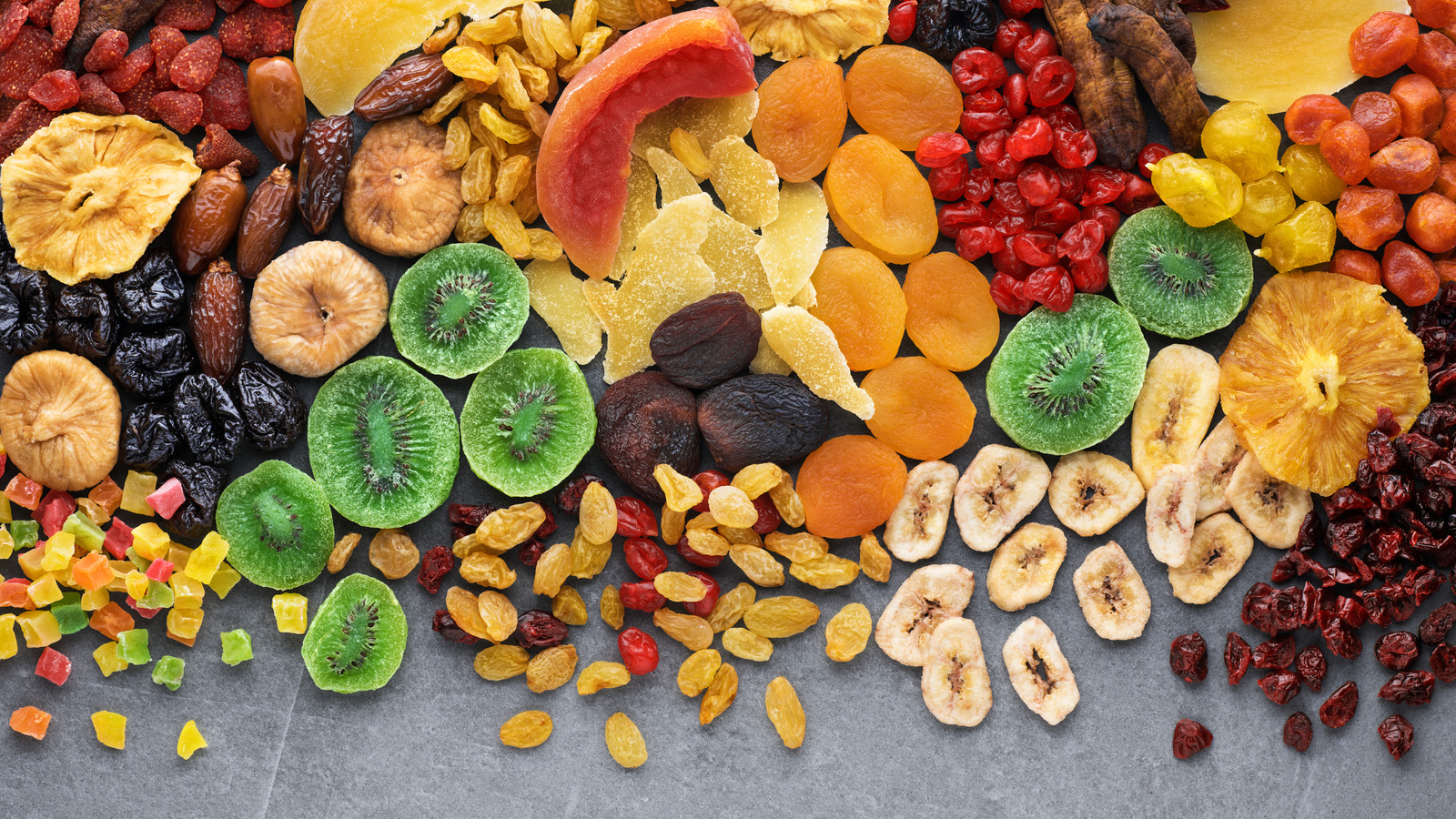Find out from a nutrition expert how to include dried fruit in your diet if you have diabetes.
According to the latest National Diabetes Statistics Report, approximately 11.3% of the U.S. population (or 37.3 million people) have diabetes and another 38% of adults (or 96 million people) over the age of 18 have prediabetes. Given these statistics, it’s important for a person with diabetes (or prediabetes) to understand how the foods they eat impact their blood sugars.
Dried fruit is a common food that a person with diabetes may wonder if they can consume (alongside other carbohydrate-based foods like bananas, potatoes and pasta, of course.) Unlike fresh fruits, dried fruit has a majority of its water content removed, making the end result a compact, highly concentrated source of nutrition. Both fresh and dried fruits provide important nutrients you need in your diet, but comparing them nutritionally is like comparing apples to oranges. For instance, a cup of grapes weighs approximately 92 grams and has 16 grams of carbohydrates, but a cup of raisins (dried grapes) weighs approximately 165 grams and has 130 grams of carbohydrates. As you can see, comparing fresh versus dried fruit from a portion-size angle just doesn’t work.
While there is a place in the diet for dried fruits, it’s important to understand how to combine these foods in a balanced diet to help prevent blood sugar spikes. But don’t worry, we’ve asked the experts how to do so, so you can feel confident in your eating choices.
How Dried Fruit Affects Your Blood Sugar
When you eat any food—dried fruits included—the sugars, or carbohydrates, found in the food are broken down and released into your bloodstream as glucose molecules. These molecules help fuel your body and provide energy. When a person without diabetes eats carbohydrates, the pancreas releases the hormone insulin to help transport, store and/or use the glucose. A person with diabetes is not able to produce or utilize insulin sufficiently, requiring them to take medication to help manage their blood sugar levels. Similarly, this also means someone with diabetes needs to carefully monitor their carbohydrate intake to appropriately dose their insulin to keep their blood sugar in check.
While all individuals—including people with diabetes—can and should consume carbohydrates as part of a balanced diet, there are certain carbohydrate-based foods that cause blood sugars to rise more quickly, dried fruit included.
According to certified diabetes educator Kim Rose, RDN, CDCES, CNSC, LD, “A person living with type 2 diabetes can eat various foods. However, certain foods may impact blood glucose levels more than others, and dried fruit may be one of those foods. Even though dried fruit contains vitamins, minerals, fiber and antioxidants, someone with diabetes should still be concerned about their blood glucose levels. Be mindful of portions, for 1 cup of dried fruit can increase blood glucose levels much more than 1 tablespoon can.”
New Jersey-based dietitian Erin Palinski-Wade, RD, CDCES, author of 2 Day Diabetes Diet, agrees with Rose that a variety-filled diet is important when managing diabetes. Palinski-Wade shares, “Portion size, fiber content and what the food is eaten in combination with all impact the extent the blood sugar will rise after consumption.”
Dried Fruit Nutrition

While there are certainly a variety of dried fruits to choose from, they are not all created equally. Palinski-Wade recommends choosing dried fruits with higher fiber content, since fiber will help slow digestion and therefore have less of an impact on blood glucose levels.
Palinski-Wade’s top choices, thanks to their fiber content, are:
Apricots (40 grams, 4 to 5 dried apricots)
- 100 calories
- 25g carbohydrates
- 22g sugar
- 3g fiber
- 1g protein
- 1mg iron
- 13mg magnesium
- 464mg potassium
Dates (40 grams, 4 dried dates)
- 110 calories
- 30g carbohydrates
- 25g sugar
- 3g fiber
- 1g protein
- 0.5mg iron
- 17mg magnesium
- 262mg potassium
Figs (40 grams, 3 to 5 dried figs)
- 110 calories
- 26g carbohydrates
- 19g sugar
- 4g fiber
- 1g protein
- 0.8mg iron
- 27mg magnesium
- 272mg potassium
Prunes (40 grams, 4 to 5 prunes)
- 100 calories
- 26g carbohydrates
- 15g sugar
- 3g fiber
- 1g protein
- 0.4mg iron
- 16mg magnesium
- 293mg potassium
Benefits of Eating Dried Fruit
May Improve Diet Quality
 A recent 2021 cross-sectional study published in the Journal of the Academy of Nutrition and Dietetics found that individuals who consumed dried fruits had higher diet quality and greater intakes of underconsumed nutrients than those who did not eat dried fruits. Given that nutrients like potassium have been included as a dietary nutrient of public health concern by the 2020-2025 Dietary Guidelines for Americans, it’s important to focus on foods like dried fruits that contain potassium to help improve dietary intake levels. With that said, the research also found that individuals who consumed the dried fruit had higher caloric intake levels on days when dried fruits were consumed. Thus, it’s important to heed Rose and Palinski-Wade’s advice and be mindful of portions and overall diet quality throughout the week.
A recent 2021 cross-sectional study published in the Journal of the Academy of Nutrition and Dietetics found that individuals who consumed dried fruits had higher diet quality and greater intakes of underconsumed nutrients than those who did not eat dried fruits. Given that nutrients like potassium have been included as a dietary nutrient of public health concern by the 2020-2025 Dietary Guidelines for Americans, it’s important to focus on foods like dried fruits that contain potassium to help improve dietary intake levels. With that said, the research also found that individuals who consumed the dried fruit had higher caloric intake levels on days when dried fruits were consumed. Thus, it’s important to heed Rose and Palinski-Wade’s advice and be mindful of portions and overall diet quality throughout the week.
May Prevent Bone Loss
A 2022 study published in the American Journal of Clinical Nutrition found that consumption of five to six prunes per day (about 50 grams) for roughly six months can prevent loss of bone mineral density in postmenopausal women, possibly reducing their risk of hip fractures. Benefits were extended when participants consumed the dried plums for 12 months, making consumption of this dried fruit a potential easy, nonpharmacologic treatment for helping prevent bone loss. Palinski-Wade notes that this is extremely important for those with diabetes, as a diabetes diagnosis increases one’s risk for developing osteoporosis.
Source: https://www.eatingwell.com








